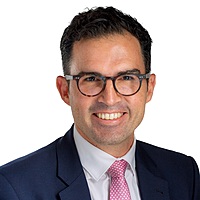3 distinct opportunities available to the yield-seeking investor
Prior to 2022, fixed income was an asset class that was associated with income and defensive-oriented characteristics, but did not offer much yield. Ultra-low interest rates, a low (but not negative growth) economic environment, and relatively few geopolitical flare-ups created the perfect environment to take risks. Until the world changes, why should you change your investment philosophy too?
But that environment is now well in the rear-view mirror. Now, income opportunities are as interesting as growth opportunities, rates are higher, and the geopolitical black swan is now more prevalent than ever. In addition, the opportunity in private markets (e.g. direct lending) is now as interesting as the opportunity in public markets (e.g. corporate bonds).
And as Teiki Benveniste, Head of Ares Australia Management points out in the latest episode of The Pitch, investing in both private and public markets is not just complementary - it is both valuable and sensible.
EDITED SUMMARY
What is the difference between private and public credit markets from an opportunity and risk perspective?
Benveniste: First of all, private markets may mean different things to different people. There's a way to think about it, and the way we think about it is that you put a delineation between public securities and private instruments.
For example, corporate bonds are public securities and loans tend to be private instruments, so that's the first thing. Bonds tend to be tradable. They have an active secondary market and so they have some level of liquidity. These are generally fixed-rate, unsecured instruments.
On the loan side, most loans are going to be senior secured and they're going to be floating rate. Inside the loan universe, you have to make the distinction between two very different markets.
One is the syndicated loan market where loans are originated by banks, there's a large syndicate of lenders and there's an active secondary market. Therefore, there is liquidity just like in the bond market. That's why, at Ares, we tend to group syndicated corporate loans and bonds together in what we call liquid credit.
The other part of the loan market, which we call direct lending, is where a loan is not originated by a bank, it's not syndicated, and there's no active secondary market. These loans are originated by a direct lender like Ares or a group of direct lenders. Generally, the loan is still floating rate, but it tends to have a higher yield relative to syndicated loans because of the complexity and the illiquidity. It tends to give you access to higher origination fees.
Why should an investor consider exposure to both private and public credit markets in today’s market?
Benveniste: All the asset classes mentioned earlier have complementary characteristics. If you think about corporate bonds, they have higher duration and credit risk associated with them. If you think about loans, because they have floating rates, they have very little duration, a credit risk premium, and some have liquidity and some don't have liquidity.
You can look at these asset classes at different points in time and they're going to show different values, so you can play the relative value between these asset classes, especially if you have a strategy that is nimble enough to do that.
You can also structure strategies for investors depending on what they're trying to achieve. If you're looking at a strategy that's seeking to extract the yield premium available in more complex illiquid assets, you can have a significant allocation to private loans and still have an allocation to some liquid credit to be able to offer liquidity windows. Also, if the liquid markets dislocate, you can go in there and take advantage.
You can have a strategy on the other hand that decides to go higher up in quality, offer daily liquidity, and have most of its investments in investment-grade securities. That will have less credit risk and lower returns, but also more liquidity. So it depends on what you're trying to achieve with your strategy.
Tell us about three ways you are taking advantage of the global credit opportunity set at Ares.
Benveniste: Right now, we feel that floating rates and senior secured instruments in those defensive companies that have been mentioned are probably the number one opportunity for us for our funds. So that's where we're going to have the biggest allocation.
Then you look at alternative credit. Where you have a debt instrument that's backed not by a corporate, but by a pool of assets. And we feel that there are very attractive opportunities in that space at the moment. One of those opportunities would be in the collateralised loan obligation (“CLO”) market. You can find BBB-rated CLO Debt that give you an extra 450 basis points over similarly rated corporate bonds.
Finally, there are still parts of the fixed rate market on the corporate side where we can find deeply discounted bonds where we think there is maybe a catalyst for repayment and a pull to par. But these opportunities are a smaller part of our portfolios at the moment.
Consistent income throughout market cycles
To learn more about how Ares Australia Management navigates inefficiencies in the market to generate attractive, income producing portfolios please visit their website.

1 fund mentioned
1 contributor mentioned



